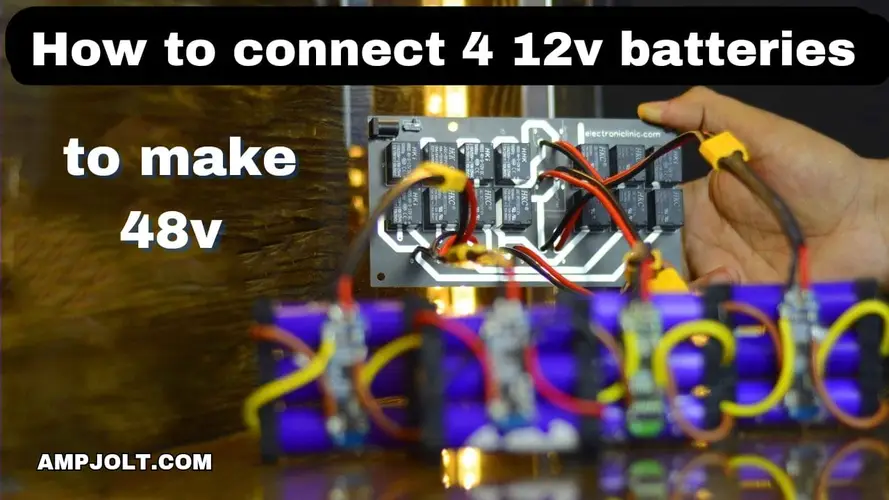Why mobility scooter battery draining fast?
April 14, 2018

In the realm of electrical systems, creating a higher voltage output often involves combining multiple batteries to achieve the desired power level. One common scenario is connecting four 12V batteries to produce a 48V power supply. Whether you're delving into renewable energy projects, powering an electric vehicle, or enhancing an off-grid solar system, understanding how to effectively connect these batteries is crucial.
To create a 48V power system with four 12V batteries, connect them in series. Start by linking the positive terminal of the first battery to the negative terminal of the second. Continue this series connection, attaching the positive terminal of the third battery to the negative terminal of the fourth. This configuration yields a 48V output.
In this comprehensive guide, we will explore the steps and considerations involved in connecting four 12V batteries to construct a 48V power bank.
Before embarking on the journey of connecting batteries, it's essential to grasp the fundamentals of voltage, current, and battery configuration. Voltage is the force that drives the flow of electric current. When batteries are connected in series, their voltages add up. In contrast, connecting batteries in parallel increases the overall current capacity while maintaining the voltage.
Now, let's delve into the step-by-step process of connecting four 12V batteries in series to create a 48V power system.
Ensure you have the necessary materials before starting the connection process:
Confirm that all four batteries have the same voltage (12V) and capacity. Mixing batteries with different specifications can lead to uneven charging and discharging, reducing the overall efficiency and lifespan of the battery bank.
Each battery has two terminals: positive (+) and negative (-). Familiarize yourself with the layout of the batteries and clearly mark the terminals to avoid confusion during the connection process.
Select a well-ventilated and dry location to set up your battery bank. Ensure there is enough space to accommodate all four batteries and that the area is easily accessible for maintenance purposes.
Follow these steps to connect the batteries in series:
Once the batteries are connected in series, secure the connections with insulating tape or heat shrink tubing. This helps prevent accidental short circuits and ensures the stability of the entire setup.
Before integrating the battery bank into your electrical system, use a multimeter to measure the voltage across the positive terminal of the first battery and the negative terminal of the fourth battery. The reading should be approximately 48V, confirming the successful series connection.
Now that you have a 48V battery bank, integrate it into your desired electrical system. This could involve connecting it to an inverter for AC power conversion or linking it to a charge controller in a solar power setup.
Regularly monitor the battery bank for signs of wear, corrosion, or any anomalies. Implement a maintenance schedule to ensure the batteries remain in optimal condition, maximizing their lifespan and efficiency.
Consider incorporating a Battery Management System (BMS) into your setup. A BMS helps manage and protect the batteries by monitoring individual cell voltages, temperatures, and balancing the charge across the cells.
Periodically perform an equalizing charge to balance the voltage levels of individual batteries within the bank. This involves slightly overcharging the battery bank to ensure all cells receive an equal charge.
Handle batteries with care and wear appropriate safety gear, such as gloves and safety glasses, during the installation process. Be cautious of short circuits and ensure all connections are secure before applying power.
Refer to the manufacturer's guidelines and specifications for your specific batteries. Different battery types may have unique requirements, and adherence to these guidelines ensures optimal performance and safety.
Creating a 48V power system by connecting four 12V batteries in series is a practical approach to meet higher voltage requirements in various applications. This step-by-step guide provides a comprehensive overview of the process, from gathering materials to integrating the battery bank into your electrical system. Remember to prioritize safety, adhere to manufacturer guidelines, and implement regular maintenance practices to ensure the longevity and efficiency of your battery setup. With careful planning and attention to detail, you can confidently build a robust 48V power system tailored to your specific needs.
To create a 24V system, connect the positive terminal of the first battery to the negative terminal of the second using a heavy-duty wire. Continue this series connection, linking the positive terminal of the second to the negative terminal of the third. The final connection yields a 24V output.
Connect four 12V batteries in series by linking the positive terminal of the first battery to the negative terminal of the second. Repeat this process, connecting the positive terminal of the third battery to the negative terminal of the fourth. The result is a 24V power system.
To achieve a 36V output, connect three 12V batteries in series. Begin by linking the positive terminal of the first battery to the negative terminal of the second. Continue this series connection, attaching the positive terminal of the second to the negative terminal of the third.
Connecting four 12V batteries in parallel maintains the voltage at 12V while increasing the overall capacity. Link the positive terminals together and the negative terminals together. This parallel connection ensures a 12V output suitable for specific applications requiring higher capacity.
Connect six 12V batteries in series to create a 24V system. Start by linking the positive terminal of the first battery to the negative terminal of the second. Repeat this series connection, attaching the positive terminal of the fifth battery to the negative terminal of the sixth.
To form a 24V power system with eight 12V batteries, connect them in series. Begin by linking the positive terminal of the first battery to the negative terminal of the second. Continue this series connection, attaching the positive terminal of the seventh battery to the negative terminal of the eighth.
Comments
Write a comment